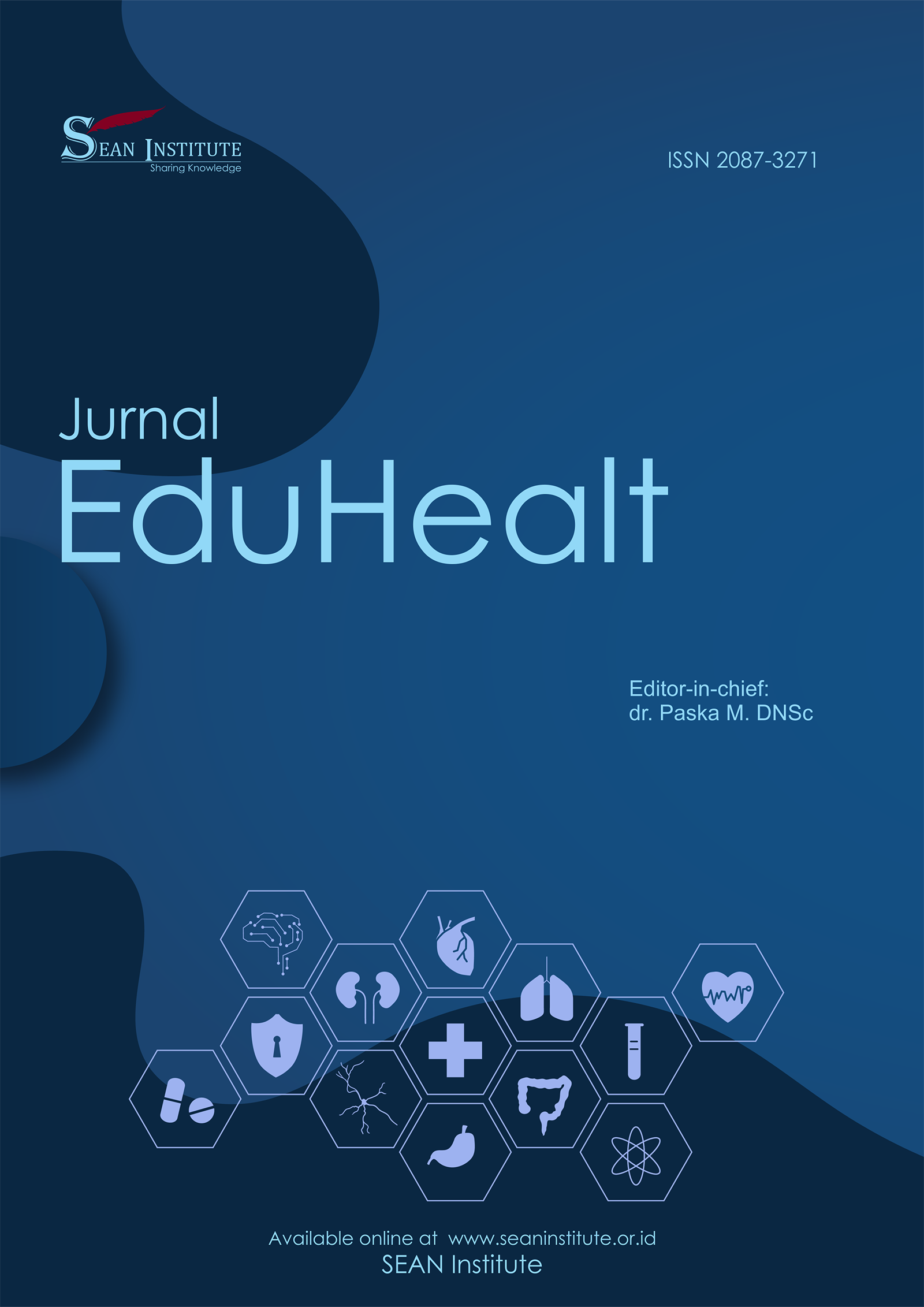Factors Associated With Preeclampsia: A Systematic Review
Keywords:
Preeclampsia, Pregnancy, Determinant, FactorAbstract
Preeclampsia remains a significant public health threat in developed and developing countries, contributing to maternal and perinatal morbidity and mortality globally. The prevalence of preeclampsia in developed countries is 1.3% - 6%, while in other developing countries it is 1.8% - 18%. Preeclampsia is a pregnancy complication characterized by an increase in blood pressure (hypertension) that usually appears after 20 weeks of gestation, accompanied by damage to organs such as the kidneys, which can be seen from the presence of protein in the urine (proteinuria). The goal is to find out what are the factors that cause preeclampsia in mothers. This study uses the Systematic Review method in accordance with the PRISMA Guidelines. The focus of the review is determined by keywords, inclusion and exclusion criteria, article search strategies with relevant databases (PubMed, Scince Direct, and Wiley), the article selection process is described in the PRISMA flowchart, Critical Appraisal using CEBM, then data extraction, and presenting the results. There are 106 articles that are removed duplicates which are then selected from titles, abstra to full text. Finally, 11 selected articles that met the inclusion criteria, Nine themes were found in this study, namely Demographic factors, Obstetric History, Health Conditions, Family Health History, ANC Visits, PAPP-P and β hCG, P53 Gene Changes, Based on Sex, Nonproteinuric and Placenta Location. In this review, an article related to the factors that cause preeclampsia in mothers was obtained, so it is recommended that researchers conduct further research related to preeclampsia management based on the causative factors. This is so that the problem of preeclampsia in mothers can be solved.
References
Aabidha, P. et al. (2015) ‘Maternal and fetal outcome in pre-eclampsia in a secondary care hospital in South India’, Journal of Family Medicine and Primary Care, 4(2), p. 257. Available at: https://doi.org/10.4103/2249-4863.154669.
Adwoa, N. (2022) ‘Prevalence and demographic distribution associated with pre-eclampsia among pregnant women at a local Teaching Hospital in Ghana’, Anesthesia and Perioperative Medicine, pp. 1–4. Available at: https://doi.org/10.36879/apm.2022.000107.
Agrawal, S. (2014) ‘Prevalence and Risk Factors for Symptoms Suggestive of Pre-Eclampsia in Indian Women’, Journal of Women’s Health, Issues & Care, 03(06). Available at: https://doi.org/10.4172/2325-9795.1000169.
Ali, A.A. et al. (2011) ‘Severe anaemia is associated with a higher risk for preeclampsia and poor perinatal outcomes in Kassala hospital, eastern Sudan’, BMC Research Notes, 4(1), p. 311. Available at: https://doi.org/10.1186/1756-0500-4-311.
Amélie Boutin, Cédric Gasse, Suzanne Demers, Geneviève Blanchet, Yves Giguère, E.B. (2018) ‘Does Low PAPP-A Predict Adverse Placenta-Mediated Outcomes in a Low-Risk Nulliparous Population? the Great Obstetrical Syndromes (GOS) Study’, J Obstet Gynaecol Can, 40(6), pp. 663–668.
Anto, E.O. et al. (2023) ‘Prevalence of preeclampsia and algorithm of adverse foeto-maternal risk factors among pregnant women in the Central Region of Ghana: A multicentre prospective cross-sectional study’, PLoS ONE, 18(6 June), pp. 1–14. Available at: https://doi.org/10.1371/journal.pone.0288079.
Anto, E.O. et al. (2024) ‘Preeclampsia in Ghana: A study on the prevalence and risk factors of postpartum readmission in the Ashanti Region’, Public Health Challenges, 3(1), pp. 1–8. Available at: https://doi.org/10.1002/puh2.154.
Asres, A.W. et al. (2022) ‘Determinants of Preeclampsia among Pregnant Women in Public Hospitals of Wolaita and Dawuro Zones, Southern Ethiopia: A Case-Control Study’, Women’s Health Reports, 3(1), pp. 964–970. Available at: https://doi.org/10.1089/whr.2022.0043.
Belay, A.S. and Wudad, T. (2019) ‘Prevalence and associated factors of pre-eclampsia among pregnant women attending anti-natal care at Mettu Karl referal hospital, Ethiopia: Cross-sectional study’, Clinical Hypertension, 25(1), pp. 1–8. Available at: https://doi.org/10.1186/s40885-019-0120-1.
Boachie-Ansah, P. et al. (2023) ‘Prevalence, Awareness, and Control of Hypertensive Disorders amongst Pregnant Women Seeking Healthcare in Ghana’, Journal of Pregnancy, 2023. Available at: https://doi.org/10.1155/2023/4194443.
Cho, J.J. et al. (2015) ‘Prior cesarean section is associated with increased preeclampsia risk in a subsequent pregnancy’, BMC Pregnancy and Childbirth, 15(1), pp. 1–6. Available at: https://doi.org/10.1186/s12884-015-0447-x.
Das, R. and Biswas, S. (2015) ‘Eclapmsia: The Major Cause of Maternal Mortality in Eastern India’, Ethiopian journal of health sciences, 25(2), pp. 111–116. Available at: https://doi.org/10.4314/ejhs.v25i2.2.
Dewi, S.R. et al. (2022) ‘Determinan Insiden Preeklamsia pada Ibu Primigravida’, JKP (Jurnal Kesehatan Primer), 7(2), pp. 124–138. Available at: https://doi.org/10.31965/jkp.v7i2.811.
Faiza et al. (2023) ‘Frequency of Primigravida in Patients With Eclampsia’, Journal of Ayub Medical College, 35(2), pp. 265–268. Available at: https://doi.org/10.55519/JAMC-02-11489.
Gathiram, P. and Moodley, J. (2016) ‘Pre-eclampsia: Its pathogenesis and pathophysiolgy’, Cardiovascular Journal of Africa, 27(2), pp. 71–78. Available at: https://doi.org/10.5830/CVJA-2016-009.
Grum, T. et al. (2017) ‘Determinants of pre-eclampsia/Eclampsia among women attending delivery Services in Selected Public Hospitals of Addis Ababa, Ethiopia: A case control study’, BMC Pregnancy and Childbirth, 17(1), pp. 1–7. Available at: https://doi.org/10.1186/s12884-017-1507-1.
Haile, T.G. et al. (2021) ‘Determinants of Preeclampsia among Women Attending Delivery Services in Public Hospitals of Central Tigray, Northern Ethiopia: A Case-Control Study’, Journal of Pregnancy, 2021. Available at: https://doi.org/10.1155/2021/4654828.
Honarjoo, M. et al. (2019) ‘Assessment of β-human-derived chorionic gonadotrophic hormone (βhCG) and pregnancy-associated plasma protein A (PAPP-A) levels as predictive factors of preeclampsia in the first trimester among Iranian women: A cohort study’, BMC Pregnancy and Childbirth, 19(1), pp. 4–8. Available at: https://doi.org/10.1186/s12884-019-2526-x.
Jani, Parul S; Patel, Uday M; Gandhi, Mayur R; Thakor, Nilesh C; Kakani, C.R. (2015) ‘Placental laterality and uterine artery resistance as predictor of preeclampsia: a prospective study at GMERS Medical College, Dharpur-Patan, North Gujarat, India.’, Biblioteca virtual em saude [Preprint].
Kakkar, T. et al. (2013) ‘Placental laterality as a predictor for development of preeclampsia’, Journal of Obstetrics and Gynecology of India, 63(1), pp. 22–25. Available at: https://doi.org/10.1007/s13224-012-0241-x.
Kementrian Kesehatan (2023) Profil Kesehatan.
Kharb, S. et al. (2022) ‘Study of Gender-based Changes in P53 in Preeclampsia’, The Open Biomarkers Journal, 12(1), pp. 1–5. Available at: https://doi.org/10.2174/18753183-v12-e2209090.
Kiondo, P. et al. (2012) ‘Risk factors for pre-eclampsia in Mulago Hospital, Kampala, Uganda’, Tropical Medicine and International Health, 17(4), pp. 480–487. Available at: https://doi.org/10.1111/j.1365-3156.2011.02926.x.
Melese, M.F., Badi, M.B. and Aynalem, G.L. (2019) ‘Perinatal outcomes of severe preeclampsia/eclampsia and associated factors among mothers admitted in Amhara Region referral hospitals, North West Ethiopia, 2018’, BMC Research Notes, 12(1), pp. 1–6. Available at: https://doi.org/10.1186/s13104-019-4161-z.
Mou, A.D. et al. (2021) ‘Prevalence of preeclampsia and the associated risk factors among pregnant women in Bangladesh’, Scientific Reports, 11(1), pp. 1–9. Available at: https://doi.org/10.1038/s41598-021-00839-w.
Muralimanoharan, S. (2013) ‘Evidence of sexual dimorphism in the placental function with severe preeclampsia’, Placenta, 34(12), pp. 1183–1189.
Njelita, I.A. et al. (2021) ‘Determinants of Preeclampsia in a Tertiary Hospital in South East Nigeria’, International Journal of Medical Science and Clinical Invention, 8(06), pp. 5490–5497. Available at: https://doi.org/10.18535/ijmsci/v8i06.08.
Nobis, P.N. and Hajong, A. (2016) ‘Eclampsia in India Through the Decades’, Journal of Obstetrics and Gynecology of India, 66(1), pp. 172–176. Available at: https://doi.org/10.1007/s13224-015-0807-5.
Otu-Nyarko, S. et al. (2022) ‘Predictors of Pre-eclampsia: A Hospital Based Study in Accra, Ghana’, Postgraduate Medical Journal of Ghana, 4(2), pp. 66–72. Available at: https://doi.org/10.60014/pmjg.v4i2.150.
Owaraganise, A. et al. (2021) ‘Nonproteinuric Preeclampsia among Women with Hypertensive Disorders of Pregnancy at a Referral Hospital in Southwestern Uganda’, Obstetrics and Gynecology International, 2021. Available at: https://doi.org/10.1155/2021/9751775.
POGI (2016) ‘PNPK Diagnosis dan Tatalaksana Preeklampsia’, pp. 1–48.
Ratna, jenni k, K.R.∙ J.R.∙ K.P.∙ S.H. (2011) ‘Decreased PAPP-A is associated with preeclampsia, premature delivery and small for gestational age infants but not with placental abruption’, European Journal of Obstetrics & Gynecology and Reproductive Biology, 157(1), pp. 48–52.
Sk, M.I.K. (2023) ‘Socioeconomic and epidemiological milieu of maternal death due to eclampsia in West Bengal, India: A mixed methods study’, Health Care Science, 2(1), pp. 45–59. Available at: https://doi.org/10.1002/hcs2.28.
Tesfahun, E. et al. (2023) ‘Prevalence of Preeclampsia and Associated Factors among Antenatal Care Attending Mothers at Tirunesh Beijing General Hospital, Addis Ababa, Ethiopia’, Advances in Public Health, 2023, pp. 3–7. Available at: https://doi.org/10.1155/2023/1132497.
Tessema, G.A., Tekeste, A. and Ayele, T.A. (2015) ‘Preeclampsia and associated factors among pregnant women attending antenatal care in Dessie referral hospital, Northeast Ethiopia: A hospital-based study’, BMC Pregnancy and Childbirth, 15(1), pp. 1–7. Available at: https://doi.org/10.1186/s12884-015-0502-7.
Vermeulen, K., Berneman, Z.N. and Van Bockstaele, D.R. (2003) ‘Cell cycle and apoptosis’, Cell Proliferation, 36(3), pp. 165–175. Available at: https://doi.org/10.1046/j.1365-2184.2003.00267.x.
Young, O.M., Twedt, R. and Catov, J.M. (2016) ‘Pre-pregnancy maternal obesity and the risk of preterm preeclampsia in the American primigravida’, Obesity, 24(6), pp. 1226–1229. Available at: https://doi.org/10.1002/oby.21412.
Yousuf, S. et al. (2016) ‘Utility of Placental Laterality and Uterine Artery Doppler Abnormalities for Prediction of Preeclampsia’, Journal of Obstetrics and Gynecology of India, 66(1), pp. 212–216. Available at: https://doi.org/10.1007/s13224-015-0837-z.
Yuanwei Fan, Graham M., R.D. (2016) ‘ HHS Public Access’, Physiology & behavior, 176(1), pp. 139–148. Available at: https://doi.org/10.1007/s11906-020-1026-8.NOVEL.

















